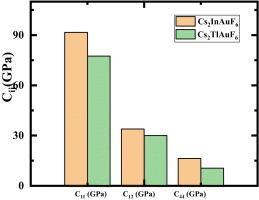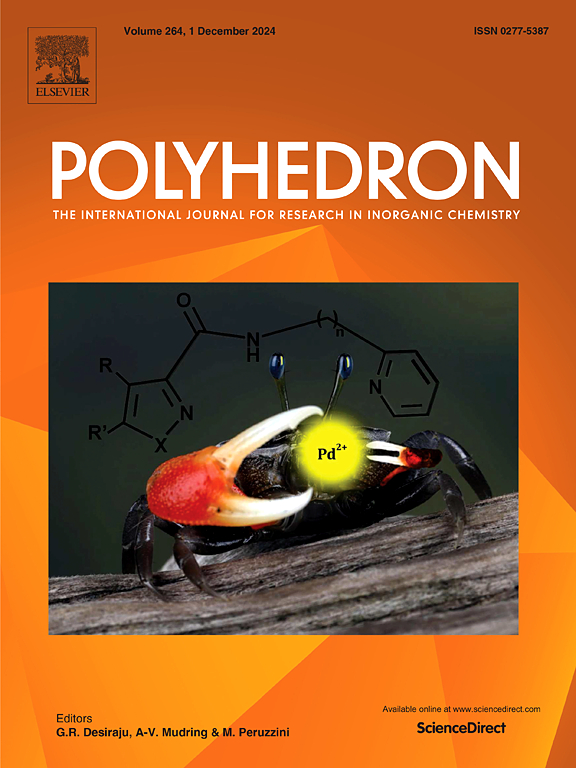Cs₂ZAuF₆(Z = In, Tl)双钙钛矿的电子、光学、热电和力学性能的第一性原理综合研究
IF 2.6
3区 化学
Q2 CHEMISTRY, INORGANIC & NUCLEAR
引用次数: 0
摘要
铯基钙钛矿作为一种无毒、热稳定、结构坚固的光电材料正受到人们的关注。本文利用密度泛函理论(DFT)对Cs2ZAuF6 (Z = In, Tl)进行了PBE-GGA、TB-mBJ和自旋轨道耦合(SOC)的研究。计算得到的弹性常数符合玻恩的稳定性准则,而硬度计算表明具有较强的抗机械应力能力。Cs2InAuF6和Cs2TlAuF6的Debye温度分别为232.5 K和186.7 K,熔点分别为1094 K和1010 K,具有高温回弹性。电子结构分析表明,直接带隙为3.47 eV (Cs2InAuF6)和1.06 eV (Cs2TlAuF6),适合于紫外光电子学,并有大量的紫外吸收。热电评估显示,Cs2InAuF6和Cs2TlAuF6的塞贝克系数高(~ 124 μV/K和~ 186 μV/K),功率因数大(~ 11.4 × 1010 W/mK2s在250 K和28 × 1010 W/mK2s在850 K), ZT值分别为1.48和1.99,导热系数低,突出了高效的能量转换。综上所述,Cs2ZAuF6 (Z = In, Tl)有望成为先进光电和热电器件的候选材料。本文章由计算机程序翻译,如有差异,请以英文原文为准。

Comprehensive first-principles investigation of electronic, optical, thermoelectric, and mechanical properties of Cs₂ZAuF₆ (Z = In, Tl) double perovskites for sustainable energy conversion
Cesium-based perovskites are gaining attention as non-toxic, thermally stable, and structurally robust materials for optoelectronic applications. In this work, we investigate Cs2ZAuF6 (Z = In, Tl) using density functional theory (DFT) with PBE-GGA, TB-mBJ, and spin–orbit coupling (SOC). The computed elastic constants comply with Born's stability criteria, while hardness calculations indicate strong resistance to mechanical stress. Debye temperatures of 232.5 K and 186.7 K, and melting points of 1094 K and 1010 K for Cs2InAuF6 and Cs2TlAuF6, respectively, demonstrate high-temperature resilience. Electronic structure analysis shows direct bandgaps of 3.47 eV (Cs2InAuF6) and 1.06 eV (Cs2TlAuF6), suitable for ultraviolet optoelectronics, corroborated by substantial UV absorption. Thermoelectric assessments reveal high Seebeck coefficients (∼124 μV/K and ∼ 186 μV/K), large power factors (∼11.4 × 1010 W/mK2s at 250 K and 28 × 1010 W/mK2s at 850 K), ZT values of 1.48 and 1.99, and low thermal conductivity for Cs2InAuF6 and Cs2TlAuF6, respectively, highlighting efficient energy conversion. Overall, Cs2ZAuF6 (Z = In, Tl) emerge as promising candidates for advanced optoelectronic and thermoelectric devices.
求助全文
通过发布文献求助,成功后即可免费获取论文全文。
去求助
来源期刊

Polyhedron
化学-晶体学
CiteScore
4.90
自引率
7.70%
发文量
515
审稿时长
2 months
期刊介绍:
Polyhedron publishes original, fundamental, experimental and theoretical work of the highest quality in all the major areas of inorganic chemistry. This includes synthetic chemistry, coordination chemistry, organometallic chemistry, bioinorganic chemistry, and solid-state and materials chemistry.
Papers should be significant pieces of work, and all new compounds must be appropriately characterized. The inclusion of single-crystal X-ray structural data is strongly encouraged, but papers reporting only the X-ray structure determination of a single compound will usually not be considered. Papers on solid-state or materials chemistry will be expected to have a significant molecular chemistry component (such as the synthesis and characterization of the molecular precursors and/or a systematic study of the use of different precursors or reaction conditions) or demonstrate a cutting-edge application (for example inorganic materials for energy applications). Papers dealing only with stability constants are not considered.
 求助内容:
求助内容: 应助结果提醒方式:
应助结果提醒方式:


